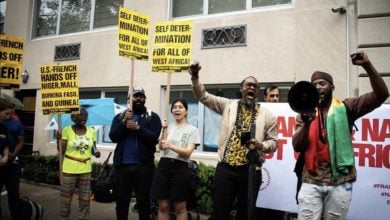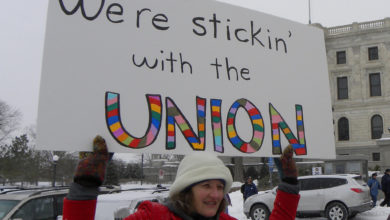In September 2004, the British medical journal Lancet released a study estimating the impact of the U.S. invasion and occupation of Iraq on the Iraqi death rate. “Making conservative assumptions,” the report concluded, “we think about 100,000 excess deaths, or more have happened since the [March] 2003 invasion of Iraq.”
 The complete obliteration of Fallujah by U.S. military in November 2004 left countless dead.
Photo: AFP/Getty Images
|
This figure did not include the wholesale massacre of Fallujah, which if included, would mean “far more” deaths.
Two full years of unrelenting brutality have passed since the release of that study.
In those two years, how many more bullets have strayed through the walls and windows of residential homes to strike innocent children? How many more farmers’ markets have been converted into war zones by sectarian death squads? How many more men and women on their way to work have pulled up to checkpoints, never to pull away?
We routinely see the pictures of the brown rubble to which Iraq, known as “the cradle of civilization,” has been reduced. But how many Iraqi families lie beneath the dust, the stones and the destroyed plaster?
No one in the corporate media wants to document the cost of the war in human terms. The U.S. government has gone out of its way to silence any discussion of the Iraqi dead, and General Tommy Franks infamously stated, “We don’t do body counts.”
Counting the dead
Counting the dead is an imprecise science because of the varying statistical methods employed and due to the periodic upsurges and downturns in violence. There has yet to be a comprehensive updated study since the Lancet report.
Sources like the well-known Iraq Body Count web project is of limited use, although the organizers do their best to report the underreported. It only counts civilian deaths caused by violence that have been reported in major Western media outlets. It does not include the lives lost to starvation, lack of medicine or other indirect but real effects of the war.
At the time of this writing, IBC accounted for a minimum of 41,639 civilian deaths. “The total number of civilians reported killed has risen year-on-year,” the site notes.
The only other Iraqi death toll figure for 2005 comes from the Interior Ministry of the puppet Iraqi government—hardly a credible source, since it is interested in portraying a stable regime. It estimated that 7,500 Iraqis were killed in 2005. It blames “terrorists” and “insurgents.” But the 2004 independent Lancet study concluded that “80 percent of violent deaths were caused by U.S. forces and that most of the people they killed were women and children.”
The Lancet study also attributed around 40 percent of the 100,000 “excess deaths” to non-violent causes, amounting to around 2,000 per month. In other words, since the start of the war there was a dramatic increase in the number of Iraqi people who died in accidents, from diseases and so on.
Considering Iraq’s unabated crisis in health care and civilian infrastructure, it is certainly plausible that this high rate of non-violent deaths would continue throughout the occupation. This would mean that the occupation caused an additional 25,000 “non-violent” Iraqi deaths in 2005 and 15,000 in 2006.
On Aug. 15, 2006, the Iraqi Ministry of Health reported that July had been the deadliest month of the entire war. According to their figures, an average of more than 110 Iraqis were killed each day—twice the number of deaths in January 2006. The United Nations, using Ministry of Health figures, estimated 17,776 Iraqi civilians died violently in the first seven months of this year.
In total, considering the Lancet study, the Fallujah massacre, the official body counts for 2005 and 2006 and the “non-violent” deaths estimated above, it is plausible that the war has killed over 200,000 Iraqis since it began in March 2003.
The national government dividing
Despite attempts to blame the majority of these deaths on the Iraqi resistance in sectarian killings, British journalist John Pilger points out that the Iraqi resistance is carrying out a campaign aimed overwhelmingly at military targets—unlike the U.S. military and their puppet troops and death squads.
 Previously part of the resistance, Mahdi Army offices have come under fire after joining the occupation government. Aug. 29, 2006.
Photo: Ali Yussef/AFP/Getty Images
|
“Seventy percent of the 1,666 bombs exploded by the resistance in July were directed against the American [sic] occupiers and 20 percent against the puppet police force,” he notes. “Unlike the collective punishment meted out by the U.S., such as the killing of several thousand people in Fallujah, the resistance is fighting basically a military war and is winning.”
There are, of course, sectarian killings—Shiites killing Sunnis and vice versa. What is rarely mentioned in the big business press, however, are the U.S. efforts to foment the sectarian attacks to prevent united Sunni-Shiite resistance to the imperialist occupation.
In fact, the Pentagon seems to be cautiously but carefully allowing the Baghdad central government to break down into a power struggle between competing Shiite parties.
The U.S.-backed Iraqi government is dominated by a coalition of Shiite parties called the United Alliance. The Alliance’s most notable members are the Dawa Party of Prime Minister Nuri al-Maliki, the Fadhila party, the Muqtada al-Sadr movement and the Iranian-backed Supreme Council for the Islamic Revolution in Iraq.
There is little real unity between these organizations. Each pursues its own narrow interests, ruthlessly shifting alliances to outmaneuver one another in their constant grab for influence and territory. For instance, in the spring, occupation forces handed Iraq’s Interior Ministry over to SCIRI, which runs the ministry through its infamous paramilitary wing, the Badr Brigade.
The Interior Ministry instantly became the country’s secret police, carrying out targeted assassinations and disappearances, fighting the resistance, attacking Sunni mosques and generally doing the “dirty work” for Washington. The Badr Brigades have also targeted Palestinian refugees in Iraq and Iraq’s gay community.
The other Shiite militia is the Mahdi Army, loyal to Muqtada al-Sadr. These forces play a more contradictory role.
Before entering the Iraqi coalition government this year, the Mahdi Army carried out resistance struggles in Najaf and Baghdad against the U.S. occupying troops. Unlike the other Shiite political forces in the government, al-Sadr routinely denounced the U.S. occupiers and their attempts to divide Sunni and Shiite communities.
Now al-Sadr forces are incorporated into the government, where they constitute the largest parliamentary voting bloc and control the Ministries of Education, Trade and Health. As such, the Mahdi Army is collaborating with U.S. occupation forces. For this reason the resistance has targeted Mahdi Army units.
On the other hand, al-Sadr continues to appeal to his base with an anti-imperialist message. On Aug. 4, he organized a pro-Hezbollah and anti-Israeli demonstration in Baghdad, which local police estimated in the hundreds of thousands. Crowds chanted, “Death to America!”
Of course, it is easier for al-Sadr to chant against U.S.-backed occupation in Palestine and Lebanon than to defy the 140,000 U.S. occupying troops in his own country. While such demonstrations are tolerated as a way to allow the masses to vent their anger in relatively safe channels, they also reveal the real sentiment of millions of Iraqis who hate imperialist occupation. The Pentagon planners couldn’t have been comfortable as their proxy war in Lebanon begin to ripple into already unstable Iraq.
Given this instability, the various factions within the Iraqi government hesitated in fulfilling its pledge to disarm their militias. The U.S. occupiers recognize the strategic role they are playing in fighting the resistance. But the factions that control the militias are also pursuing their own agendas.
On Aug. 28, a deadly territorial battle broke out between the Mahdi Army and Iraqi security forces aligned with the dominant SCIRI faction. The two sides agreed to a truce, but the fighting revealed the contradictions within the U.S.-orchestrated coalition.
With the occupying forces now relying on death squads, turf wars are breaking out on the streets of Baghdad. Competing Shiite militias carry out attacks in predominantly Sunni neighborhoods and residents take action to defend their communities.
U.S. plans to tear apart Iraq
The occupation forces have failed to stabilize a U.S.-friendly national government in Baghdad. The plan to return the oil-rich nation of Iraq to its status as a neo-colony of Washington, as it was prior to its 1958 revolution, is every day less likely to succeed. This is first and foremost a reflection of the strength, determination and mass support of the Iraqi resistance forces.
The U.S. imperialists now appear to have other plans. The occupation forces are now allowing internecine and sectarian conflict—which they have promoted all along—to tear the country apart.
The plan to partition Iraq could be seen in the October 2005 Iraqi constitution. In the name of “federalism,” it spelled out a system that guaranteed regional governmental autonomy should the central Baghdad government prove too weak or fall out of Washington’s control. This system could at least guarantee Wall Street access to the oil-rich areas of the north and the south.
In the south, there is a hotly contested battle for influence among the Shiite parties. Their shifting alliances and periodic clashes have left the area fractured and increasingly susceptible to foreign control.
In the oil-rich north, which is predominantly Kurdish, government buildings are already flying the flags of Kurdistan instead of Iraq. The Kurds are an oppressed people that have long been denied their right to statehood—not just in Iraq, but in historic Kurdistan including large parts of imperialist ally Turkey. But a semi-state whose existence depends completely on remaining a U.S. protectorate is a far cry from genuine self-determination.
Like most modern states, Iraq was formed after a long process of struggles between clans and warlords. The U.S. dismemberment plan roughly aims to return Iraq to that pre-state stage of development.
Already, Iraq’s infrastructure has been wiped out. The nation has now suffered 15 uninterrupted years of devastation. It is likely that over 2 million Iraqis have died during this period.
Iraq, once a secular state with extensive social programs and an education system that made it the envy of the Middle East, has been torn apart.
The only force capable of halting the U.S. plans to exterminate the Iraqi nation is an increasingly effective Iraqi resistance united on the basis of anti-imperialism.





